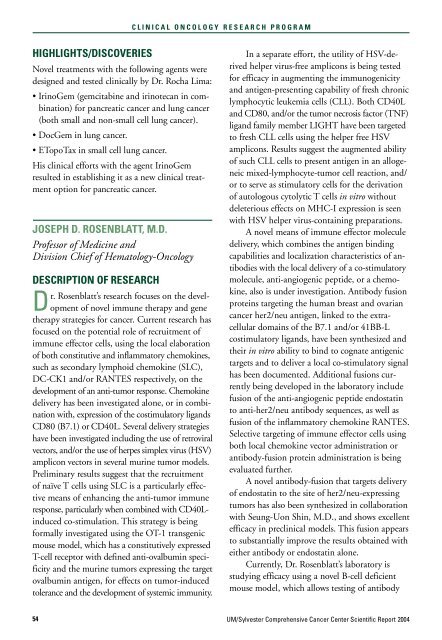SCIENTIFIC REPORT 2004 - Sylvester Comprehensive Cancer Center
SCIENTIFIC REPORT 2004 - Sylvester Comprehensive Cancer Center
SCIENTIFIC REPORT 2004 - Sylvester Comprehensive Cancer Center
Create successful ePaper yourself
Turn your PDF publications into a flip-book with our unique Google optimized e-Paper software.
C L I N I C A L O N C O L O G Y R E S E A R C H P R O G R A M<br />
HIGHLIGHTS/DISCOVERIES<br />
Novel treatments with the following agents were<br />
designed and tested clinically by Dr. Rocha Lima:<br />
• IrinoGem (gemcitabine and irinotecan in combination)<br />
for pancreatic cancer and lung cancer<br />
(both small and non-small cell lung cancer).<br />
• DocGem in lung cancer.<br />
• ETopoTax in small cell lung cancer.<br />
His clinical efforts with the agent IrinoGem<br />
resulted in establishing it as a new clinical treatment<br />
option for pancreatic cancer.<br />
JOSEPH D. ROSENBLATT, M.D.<br />
Professor of Medicine and<br />
Division Chief of Hematology-Oncology<br />
DESCRIPTION OF RESEARCH<br />
Dr. Rosenblatt’s research focuses on the development<br />
of novel immune therapy and gene<br />
therapy strategies for cancer. Current research has<br />
focused on the potential role of recruitment of<br />
immune effector cells, using the local elaboration<br />
of both constitutive and inflammatory chemokines,<br />
such as secondary lymphoid chemokine (SLC),<br />
DC-CK1 and/or RANTES respectively, on the<br />
development of an anti-tumor response. Chemokine<br />
delivery has been investigated alone, or in combination<br />
with, expression of the costimulatory ligands<br />
CD80 (B7.1) or CD40L. Several delivery strategies<br />
have been investigated including the use of retroviral<br />
vectors, and/or the use of herpes simplex virus (HSV)<br />
amplicon vectors in several murine tumor models.<br />
Preliminary results suggest that the recruitment<br />
of naïve T cells using SLC is a particularly effective<br />
means of enhancing the anti-tumor immune<br />
response, particularly when combined with CD40Linduced<br />
co-stimulation. This strategy is being<br />
formally investigated using the OT-1 transgenic<br />
mouse model, which has a constitutively expressed<br />
T-cell receptor with defined anti-ovalbumin specificity<br />
and the murine tumors expressing the target<br />
ovalbumin antigen, for effects on tumor-induced<br />
tolerance and the development of systemic immunity.<br />
In a separate effort, the utility of HSV-derived<br />
helper virus-free amplicons is being tested<br />
for efficacy in augmenting the immunogenicity<br />
and antigen-presenting capability of fresh chronic<br />
lymphocytic leukemia cells (CLL). Both CD40L<br />
and CD80, and/or the tumor necrosis factor (TNF)<br />
ligand family member LIGHT have been targeted<br />
to fresh CLL cells using the helper free HSV<br />
amplicons. Results suggest the augmented ability<br />
of such CLL cells to present antigen in an allogeneic<br />
mixed-lymphocyte-tumor cell reaction, and/<br />
or to serve as stimulatory cells for the derivation<br />
of autologous cytolytic T cells in vitro without<br />
deleterious effects on MHC-I expression is seen<br />
with HSV helper virus-containing preparations.<br />
A novel means of immune effector molecule<br />
delivery, which combines the antigen binding<br />
capabilities and localization characteristics of antibodies<br />
with the local delivery of a co-stimulatory<br />
molecule, anti-angiogenic peptide, or a chemokine,<br />
also is under investigation. Antibody fusion<br />
proteins targeting the human breast and ovarian<br />
cancer her2/neu antigen, linked to the extracellular<br />
domains of the B7.1 and/or 41BB-L<br />
costimulatory ligands, have been synthesized and<br />
their in vitro ability to bind to cognate antigenic<br />
targets and to deliver a local co-stimulatory signal<br />
has been documented. Additional fusions currently<br />
being developed in the laboratory include<br />
fusion of the anti-angiogenic peptide endostatin<br />
to anti-her2/neu antibody sequences, as well as<br />
fusion of the inflammatory chemokine RANTES.<br />
Selective targeting of immune effector cells using<br />
both local chemokine vector administration or<br />
antibody-fusion protein administration is being<br />
evaluated further.<br />
A novel antibody-fusion that targets delivery<br />
of endostatin to the site of her2/neu-expressing<br />
tumors has also been synthesized in collaboration<br />
with Seung-Uon Shin, M.D., and shows excellent<br />
efficacy in preclinical models. This fusion appears<br />
to substantially improve the results obtained with<br />
either antibody or endostatin alone.<br />
Currently, Dr. Rosenblatt’s laboratory is<br />
studying efficacy using a novel B-cell deficient<br />
mouse model, which allows testing of antibody<br />
54<br />
UM/<strong>Sylvester</strong> <strong>Comprehensive</strong> <strong>Cancer</strong> <strong>Center</strong> Scientific Report <strong>2004</strong>
















